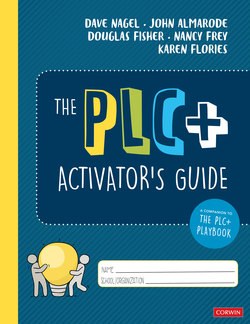Читать книгу The PLC+ Activator’s Guide - Douglas Fisher - Страница 9
На сайте Литреса книга снята с продажи.
Part 1 Activating Your PLC+ Overview
ОглавлениеAre you ready to activate your PLC+? Strong activation is essential for success in all PLC+ settings. PLC+ teams will face many challenges and ups and downs through the course of a school year. The role of the activator is critical to the success of the PLC+ framework in moving forward the learning of both the adults and the students the PLC+ team serves. Many previous PLC models and frameworks have disregarded the role human behavior plays when it comes to collaborative efforts to impact student learning at high levels. The PLC+ framework takes into account this critical element of human behavior on a deep level, with activation as one of its crosscutting values. Activators have the ability to move a PLC+ team from chaos and dysfunction into impactful action, from where team members are stagnant to where they are thriving. Activators ensure their teams’ PLC+ journeys are focused on the learning and development of both adults and the students they teach. In doing so, activators arm their teams to weather the storms that will certainly come their way and to overcome any challenges they will face.
A Close Look at the PLC+ Value of Activation
Spotsylvania County Public Schools (SCPS) is the 12th-largest school division in the state of Virginia. SCPS consists of 29 schools and has an enrollment of approximately 24,000 students. It is a rural school system that rests between Washington, DC, and Richmond and has experienced significant changes in student demographics over the past 15 years. Like many school divisions in Virginia, SCPS has experienced state and federal sanctions for underachieving schools due to an increase in rigor on state assessments and accountability revisions.
The core belief of SCPS is that all learners have the right to high-quality instruction, and PLC+ is the vehicle by which they will bring this core belief to actualization. Division Superintendent Dr. Scott Baker recognized the value of professional learning communities and, at the same time, noticed the immediate need to refocus the current approach to how these teams of educators operated within schools. Dr. Baker, drawing from firsthand experiences as an educator, building-level leader, and district-level leader, recognized that the best pathway to the success of PLCs was to embed this important initiative in classrooms and to entrust it to those doing the work in classrooms: the teacher. Dr. Baker believes that the plus is the teacher and the focus should be on the critical role teachers play in student learning for SCPS. By acknowledging that the plus is the teacher—every teacher in SCPS—Dr. Baker envisioned that the perception of “us,” the teachers, and “they,” the central office staff, would evolve into “we”—together, engaged in teaching and learning with intention and purpose, which is best for the learners in SCPS. Therefore, he made the decision to make this a district-wide focus, as well as the focus of his instructional leadership team.
The SCPS instructional leadership team, under the direction of Dr. Carol Flenard, Deputy Superintendent and Chief Academic Officer, determined that it would work to revitalize the division’s PLCs district wide, as capacity-building vehicles that sustain change in teacher practice and thus student growth in learning and achievement. Members of the initiative began their journey by engaging in professional learning as an instructional leadership team. This required deep learning around the PLC+ framework, the four crosscutting values, and the deliberate, intentional, and purposeful analysis of each module in The PLC+ Playbook.
However, one afternoon during an instructional leadership meeting, the conversation about district-wide implementation came to a screeching halt. The implementation, excuse me, the successful implementation of PLC+ in a district with 29 different locations required meticulous and diligent identification and support of the initial activators to serve as the catalyst for implementing PLC+ across the district, rendering action or accelerating this revitalization of the PLCs of SCPS. Without this catalyst or the initial activators embracing this particular crosscutting value of activation, the PLC+ would likely spiral into “another meeting.” We will check in with the work of this particular school district as we progress through the other parts of this guide for activators. However, the recognition of the importance of identifying and supporting activators brings us to the first part of this guide. What makes an activator effective?
